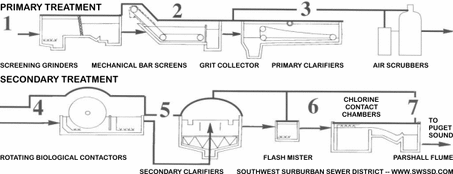TREATMENT OVERVIEW
|
1 -- Wastewater enters through a step screen system, where the paper and plastics are removed and taken to landfills.
2 -- The influent then moves through a grit removal process, which removes the heaviest particles and sand that are carried with the sewage. 3 -- Primary clarifiers are the next step; these are large tanks where solids sink to the bottom to be collected by mechanical scrapers while floatable waste is skimmed off the top. Before secondary treatment, wastewater moved from the primary clarifiers to chlorine contact chambers, and then directly into Puget Sound. 4 -- From primary clarifiers, wastewater is moved to intermediary tanks where large plastic cylinders (Rotating Biological Contactors, RBC's) are rotated through it. These cylinders are covered with bacteria that literally eat much of the pollutants and oxygen-demanding components wastewater contains. 5 -- Following exposure to the "pollution-eating" bacteria, wastewater enters secondary clarifiers where additional solids are settled out. 6 -- Wastewater then passes to the chlorine mixing and contact chambers, where sodium hypochlorite is introduced to disinfect the effluent. 7 -- Processed effluent is then released 2000 feed off-shore and 230 feet beneath the surface of Puget Sound. |
